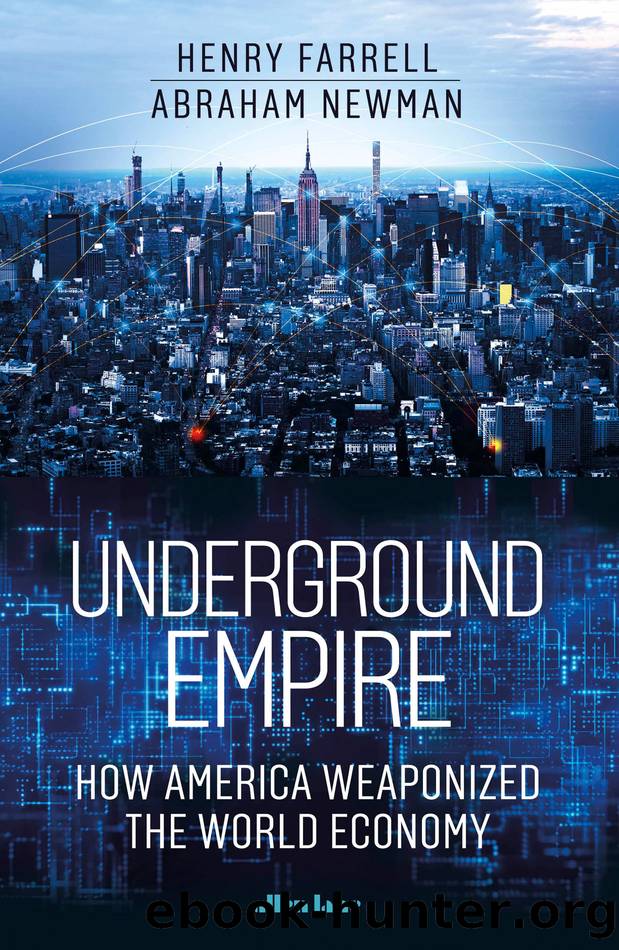Underground Empire by Henry Farrell & Abraham Newman

Author:Henry Farrell & Abraham Newman [Farrell, Henry & Newman, Abraham]
Language: eng
Format: epub
ISBN: 9781802062083
Publisher: Penguin Random House UK
Published: 2023-07-14T00:00:00+00:00
* * *
LinkedIn wasnât only useful for wartime defense. Shortly before the Ukraine war began, the Taiwanese semiconductor giant TSMC put up a help wanted notice54 on the service: âAs our business continues to grow globally in scale and complexity, we are looking for a Business Intelligence Analyst who is interested in translating geopolitical and economic changes to impact on IC [integrated circuit] industry supply chain.â
The bland language belied the urgency of TSMCâs plea. TSMCâs leaders had reason to fear that geopolitics would devour their company.
TSMC had been founded as a bet on the globalized economy. Open markets and rapid communication allowed semiconductor companies to find their niche, specializing in one aspect of production rather than trying to do everything in-house. Companies like TSMC focused narrowly on the things they could do well, making sure they did them better than the competition. TSMC was a âpure playâ fabrication (fab, for short) company, manufacturing semiconductors that were designed elsewhere. It could focus more easily on production improvements than integrated manufacturers such as Intel, squeezing out little innovations as well as big ones in regular increments.
In 1998, TSMCâs founder and then CEO, Morris Chang, laid out TSMCâs strategy in an internal document.55 He believed that if TSMC built deep relations with customers, learned what they wanted, and properly integrated sales and engineering, it would become the biggest silicon foundry in the world, more or less as a matter of course. To do this right, TSMC needed to solve two problems.
First, it needed to build trust with its customers, the technology companies that ordered specialized chips from TSMC. These companies competed furiously with each otherâTSMC might make processor chips for many different phone manufacturers, each struggling to win or protect its own market share from the others. Each customer had to work closely with TSMC, providing highly sensitive information about their technological needs and business strategies to a company that also had close relationships with their most bitter adversaries. That was why Chang believed that TSMC had to credibly guarantee that it would keep their proprietary information secret.
TSMC would have to seem completely even-handed. Changâs strategy document mandated that if TSMC provided a special âonetimeâ deal to one of its customers, it would offer âsimilar dealsâ to the customerâs direct competitors in the same field, to avoid any impression of favoritism. Such strategies allowed TSMC to become what the Wall Street Journal described as the âSwitzerland of semiconductors,â56 working impartially with competitors like NVIDIA and Qualcomm to build their chips.
Second, TSMC needed to tech up, catching up with its competitorsâ ability to produce sophisticated semiconductors, and eventually beating them. TSMC started by catering to niches that bigger competitors like Intel didnât care to compete in. It grew by combining its own know-how with the information it got from customers from around the world. That allowed it to enter new markets. Customers didnât just bring economies of scale, allowing TSMC to produce more cheaply. They brought economies of knowledge, providing TSMC with an unrivaled
Download
This site does not store any files on its server. We only index and link to content provided by other sites. Please contact the content providers to delete copyright contents if any and email us, we'll remove relevant links or contents immediately.
| Accounting | Economics |
| Exports & Imports | Foreign Exchange |
| Global Marketing | Globalization |
| Islamic Banking & Finance |
50 Economics Classics by Tom Butler-Bowdon(2071)
Six Billion Shoppers by Porter Erisman(2001)
Why Nations Fail: The Origins of Power, Prosperity, and Poverty by Daron Acemoglu & James Robinson(1791)
No Time to Say Goodbye(1765)
The Economist [T6, 22 Thg9 2017] by The Economist(1646)
Red Notice by Bill Browder(1596)
Currency Trading For Dummies by Brian Dolan(1550)
Thank You for Being Late by Thomas L. Friedman(1458)
Bitcoin: The Ultimate Guide to the World of Bitcoin, Bitcoin Mining, Bitcoin Investing, Blockchain Technology, Cryptocurrency (2nd Edition) by Ikuya Takashima(1420)
Amazon FBA: Amazon FBA Blackbook: Everything You Need To Know to Start Your Amazon Business Empire (Amazon Empire, FBA Mastery) by John Fisher(1304)
The Great Economists by Linda Yueh(1186)
Coffee: From Bean to Barista by Robert W. Thurston(1184)
The Future Is Asian by Parag Khanna(1174)
Pocket World in Figures 2018 by The Economist(1157)
Capitalism Without Capital: The Rise of the Intangible Economy by Jonathan Haskel(1130)
Grave New World by Stephen D. King(1111)
How Money Got Free: Bitcoin and the Fight for the Future of Finance by Brian Patrick Eha(1106)
The Sex Business by Economist(1088)
Cultural Intelligence by David C. Thomas(1013)
